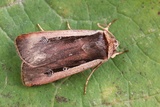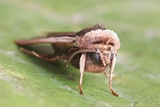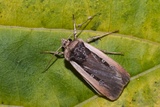Ochropleura leucogaster (Freyer, [1831]) Species
Last modified: Dec. 18, 2025, 4:59 p.m.
First observation of this very rare migrant for Belgium was in autumn 2019 in WV.
Details
- Classification
- Family: Noctuidae > Subfamily: Noctuinae > Tribus: Noctuini > Genus: Ochropleura > Species: Ochropleura leucogaster
- Vernacular names
- Sierlijke haarbos (NL), Radford's Flame Shoulder (EN), Agrotide à ventre blanc (FR), Südalpen-Erdeule (DE)
- First mention in Belgium
- Steeman C. & Sierens T. 2020. Interessante waarnemingen van Lepidoptera in België in 2019 (Lepidoptera) — Phegea 48(2): 26–40. On page 35. view page
- Status
-
Migrant
For your information, to the best of our knowledge, the first 10 Belgian observations are listed here:
1) 1 ♂ on 23.x.2019 at Hooglede (WV), leg. & gen. det. W. Declercq.
2) 1 ♂ on 09.xi.2020 at Esneux (LG), leg. E. Wille, gen. det. C. Steeman.
3) 1 ex. on 27.x.2022 at Raversijde (WV), leg. R. Allaert et al.
4) 1 ex. on 25.ix.2023 at Raversijde (WV), leg. R. Allaert et al.
5) 1 ex. 30.ix.2023 at Oostende (WV), leg. J. Rottiers.
6) 1 ex. on 02.x.2023 at Wenduine (WV), leg. S. Stevens.
7) 2 ex. on 22.ix.2024 at Wenduine (WV), leg. A. Beidts.
8) 1 ex. on 22.ix.2024 at Bredene (WV), leg. L. Decrick et al.
9) 1 ex. on 23.ix.2024 at De Panne (WV), leg. L. Decrick et al.
10) 1 ex. on 26.ix.2024 at Raversijde (WV), leg. R. Allaert.
Distribution
Bionomics
Larvae can be found year-round and live quite concealed near the ground at daytime.
Flight periods
Adults are on the wing year-round, but most vagrants are seen during autumn.
Species seen in Belgium were from late September till early November.
Observed on
The larva is polyphagous on grasses and herbs like various Poaceae, Trifolium, Rumex, Oxalis, etc...
Habitat
It inhabits especially humid to wet places with dense, but more short growing vegetation.



